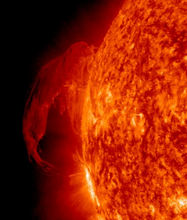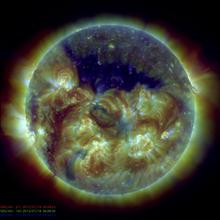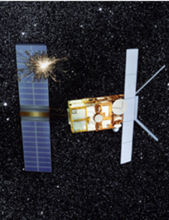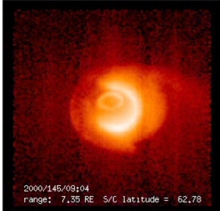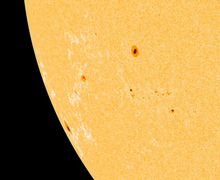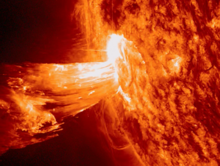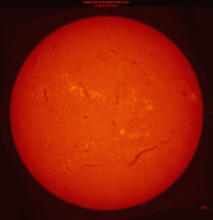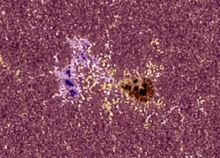news
Submitted on 2013-07-31
The month of July saw some really great prominence activity. Prominences are relatively cool and dense structures reaching all the way up into the Sun's hot outer atmosphere. This movie shows nine events picked from a long list.

Submitted on 2013-07-18
Most often, people think about high energetic protons, space debris and altitude loss from an expanding atmosphere as the most important threats to the survival of earth-orbiting satellites. However, also the abundantly present electrons can constitute a lethal danger to the satellite's life. Many satellites such as Telstar 401 and Galaxy IV did not recover from electron induced effects, so two of them will be sketched here.
Submitted on 2013-07-11
The plasmasphere is a region of "cold" (low-energetic) particles that extends from about 1600 km to over 30000 km above Earth's surface. It is an extension of the ionosphere, and overlaps the inner Van Allen radiation belt and a good part of the outer one. The difference between the plasmasphere and the Van Allen belts is that the latter contain "hot" (high-energetic) particles that behave according to a whole different set of rules.

Submitted on 2013-07-04
Last week, the remainder of a large sunspot complex rounded the west limb. For more than 2 weeks, it had dominated the outlook of the Sun. Initially consisting of 6 groups, only the two largest groups survived the transit over the solar disk. The graph underneath shows the daily sunspot number from 9 till 30 June as determined from SDO/HMI continuum images (1024x1024).

Submitted on 2013-06-25
During the early hours of 21 June, the relatively simple sunspot group NOAA 1777 unleashed a medium class solar flare. The M2.9 flare peaked at 03:14UT, and lasted for 73 minutes. Its x-ray signature clearly dominated the x-ray solar activity for that day.

Submitted on 2013-06-19
While last week was quite a bummer with respect to sunspot activity, the chromosphere offered a much more appealing view. Indeed, during a few days, various filaments of medium length were visible all over the solar surface, with one even attaining 400.000 km. These filaments can be seen in the Kanzelhöhe image underneath, taken on 12 June.

Pages
Zircon - This is a contributing Drupal Theme
Design by
WeebPal.

